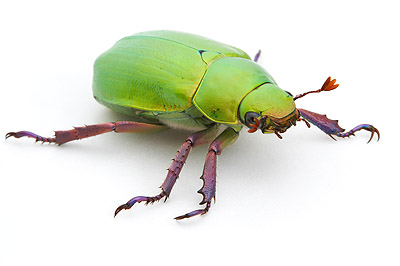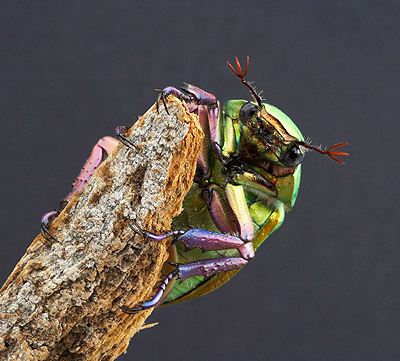
Chrysina beyeri - Beyer's Scarab - Arizona
Arizona's Jewel Scarabs emerge after the onset of summer rains. These large insects have something of a cult following among collectors, and enthusiasts from around the world descend on the Sonoran desert every monsoon season with their mercury vapor lamps and blacklights to entice the lumbering beetles into their traps. The effects of this mass harvesting on Chrysina populations have not been studied, but they should be. I'd hate to lose such an attractive species.
Beyer's scarab, the largest Chrysina in the United States, feeds on oak foliage.

photo details (both images): Canon 100mm f2.8 macro lens on a Canon EOS 20D
ISO 100, f/18, 1/250 sec, indirect strobe in white box

Aww, look at those purple feet. And don't forget, their green reflectance is circularly polarized! Fancy-pants rutelines.
As an off-topic FYI, you were the featured (in the form of a two-line description and link to here) photographer in the Knox County, Ohio, Art Association newsletter this month. Congratulations! :)
"The effects of this mass harvesting on Chrysina populations have not been studied, but they should be."
If we want to truly understand anthropogenic threats to this species, any such study should also include the impacts of land clearing for agriculture and homesite development, water table changes resulting from irrigation and domestic water consumption, plant community alterations due to human land use patterns, invasion by exotics, and induced climate change, increased small predator abundance resulting from extirpation of larger predators, etc. I suspect the numbers taken by collectors might appear triffling when all human impacts are properly assigned.
Ainsley- "Circularly polarized"? That sounds awesome. I have no idea what it means.
RBH- Really? Ohio? That's great. If I can make it big in Ohio, I can make it anywhere. :)
Ted- Absolutely. But, it'd sure be nice to have some quantitative estimate of the collection effect so we can know with some confidence not to worry about it.
Circularly polarized: as green light (anything with a wavelength ~550nm) is reflected from the cuticle, the vectors of those light waves rotate counter-clockwise. You can then knock out the polarized green light with a quarterwave plate + linear polarizer.
e.g. http://nature.berkeley.edu/~seago/chrysina_example.jpg
We have absolutely no idea what adaptive purpose (if any) this serves, but it's a decent synapomorphy for Rutelinae. :)